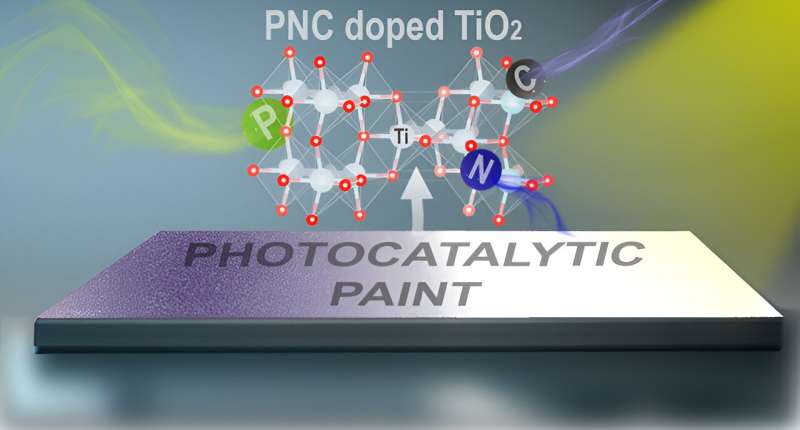
Typically, beautiful white wall paint does not stay beautiful and white forever. Often, substances from the air accumulate on its surface. This can be a desired effect because it makes the air cleaner for a while—but over time, the color changes and needs to be renewed.
A research team from TU Wien and the Università Politecnica delle Marche (Italy) has now succeeded in developing special titanium oxide nanoparticles that can be added to ordinary, commercially available wall paint to establish self-cleaning power: The nanoparticles are photocatalytically active, they can use sunlight not only to bind substances from the air, but also to decompose them afterwards.
The wall makes the air cleaner—and cleans itself at the same time. Waste was used as the raw material for the new wall paint: metal scrap, which would otherwise have to be discarded, and dried fallen leaves. The study is published in ACS Catalysis.
Modified titanium oxide in the wall paint
A wide variety of pollutants occur in indoor air—from residues of cleaning agents and hygiene products to molecules that are produced during cooking or that are emitted by materials such as leather. In some cases, this can lead to health issues, which is then referred to as “sick building syndrome.”
“For years, people have been trying to use customized wall paints to clean the air,” says Prof. Günther Rupprechter from the Institute of Materials Chemistry at TU Wien. “Titanium oxide nanoparticles are particularly interesting in this context. They can bind and break down a wide range of pollutants.”
However, simply adding ordinary titanium oxide nanoparticles to the paint will affect the durability of the paint: just as pollutants are degraded by the nanoparticles, they can also make the paint itself unstable and create cracks. In the worst case, volatile organic compounds can even be released, which in turn can be harmful to health. After a certain time, the paint layer becomes gray and tinted, finally it has to be renewed.
Self-cleaning by light
However, the nanoparticles can clean themselves if they are irradiated with UV light. Titanium oxide is a so-called photocatalyst—a material that enables chemical reactions when exposed to suitable light. The UV radiation creates free charge carriers in the particles, which induce decomposition of the trapped pollutants from air into small parts and their release. In this way, the pollutants are rendered harmless, but do not remain permanently attached to the wall paint. The wall color remains stable in the long term.
In practice, however, this is of little use—after all, it would be tedious to repeatedly irradiate the wall with intense UV light in order to drive the self-cleaning process. “Our goal was therefore to modify these particles in such a way that the photocatalytic effect can also be induced by ordinary sunlight,” explains Rupprechter.
This is achieved by adding certain additional atoms to the titanium oxide nanoparticles, such as phosphorus, nitrogen, and carbon. As a result, the light frequencies that can be harvested by the particles change, and instead of just UV light, photocatalysis is then also triggered by ordinary visible light.

96% pollutant removal
“We have now investigated this phenomenon in great detail using a variety of different surface and nanoparticle analysis methods,” says Qaisar Maqbool, the first author of the study. “In this way, we were able to show exactly how these particles behave, before and after they were added to the wall paint.”
The research team mixed the modified titanium oxide nanoparticles with ordinary, commercially available wall paint and rinsed a painted surface with a solution containing pollutants. Subsequently, 96% of the pollutants could be degraded by natural sunlight. The color itself does not change—because the pollutants are not only bound, but also broken down with the help of sunlight.
Waste as a raw material
For the commercial success of such paints, it is also important to avoid expensive raw materials. “In catalysis, for example, precious metals such as platinum or gold are used. In our case, however, elements that are readily available from everywhere are sufficient: To obtain phosphorus, nitrogen and carbon, we have used dried fallen leaves from olive trees, and the titanium for the titanium oxide nanoparticles was obtained from metal waste, which is normally simply thrown away,” says Rupprechter.
This new type of wall paint combines several advantages at the same time: it removes pollutants from the air, it lasts longer than other paints—and it is even more resource-saving in production as it can be obtained from recycled materials. Further experiments are being carried out, and commercialization of the wall paint is intended.
More information:
Qaisar Maqbool et al, Highly Stable Self-Cleaning Paints Based on Waste-Valorized PNC-Doped TiO2 Nanoparticles, ACS Catalysis (2024). DOI: 10.1021/acscatal.3c06203
Journal information:ACS Catalysis
Provided by
Vienna University of Technology

READ MORE
Tiny nanoparticles offer large potential for brain cancer treatment
Credit: Yale University For patients with malignant brain tumors, the prognosis remains dismal. With the [...]
New study calls into question prior study results that found tumor transmission slowing in Tasmanian devils
Credit: CC0 Public Domain A trio of biologists and veterinarians with CRG Barcelona, the University [...]
9 of the Largest Eagles in the World
The Steller’s sea eagle is the only species to make all three lists of the [...]
Successful visualization of two-dimensional electron gas in high-frequency/power devices
Schematic diagrams of the DPC STEM and tDPC STEM techniques. Credit: Nature Nanotechnology (2023). DOI: [...]
Can’t Make It to the Moon? Head to Arizona Instead
/ Cinder Lake Crater Fields, as seen from above. U.S. Geological Survey/photo by Jon Mason [...]
Bandicoots Survived Eons of Changing Climates, But This Time It’s Different
The greater bilby (Macrotis lagotis) is a bandicoot relative currently facing habitat struggles due to [...]
Can a sound wave kill you?
Worst case scenario, your sister’s trumpet playing will just make you feel like your head’s [...]
Petrified Wood: A Journey From Tree to Stone
Petrified Forest National Park, located in northeast Arizona, is home to a number of animal [...]